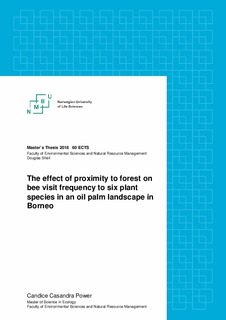| dc.description.abstract | Pollination is critical for global food security as it ensures the reproduction of many wild and crop plants. Pollination services may be at risk as tropical rainforests are rapidly being destroyed and degraded, largely due to agricultural expansion.
In this study I assessed the ability of a mixed forest and oil palm landscape in West Kalimantan, Borneo, Indonesia to sustain bees. I quantified bee visitation frequency by observing visits to four crop plants, Citrullus lanatus (watermelon), Capsicum frutescens (chili), Solanum lycopersicum (tomato), and Solanum melongena (eggplant); one native colonizing plant Melastoma malabathricum; and one exotic species Turnera subulata. I examined the relationships between visitation frequencies and distance from forest; distance from oil palm; size of the nearest forest; and environmental conditions. I also assessed the feasibility of using automatic cameras to observe pollinator visits and whether visitation rates varied among plant species. My observations combine two studies: Study 1 was a small scale grid-based study with six plant species observed in a cleared area at distances up to 208m from natural forest and 144m from oil palm. Study 2 was a large scale transect study with observations conducted on T. subulata planted within oil palm at distances up to 2130m from natural forests.
In Study 1 I recorded 355 bee visits in 723 ten-minute observation periods from July 22nd to September 5th, 2017. In Study 2 I recorded 894 bee visits in 323 observation periods from October 15-29th, 2017. Analyses revealed a positive relationship with visit frequency and temperature in Study 1. In both studies there were positive relationships between visit frequency and sunlight while there was a negative relationship with time of day. The use of cameras had a negative relationship, when compared to direct observations, with observed visitation frequency in Study 1 but a slightly positive relationship in Study 2. Visitation frequency varied among the observed plant species (ranging from 0 observed visits to S. lycopersicum to an average of 0.62 visits/flower/per ten minutes to C. lanatus), with C. frutescens and S. lycopersicum receiving significantly lower visitation frequencies than the other species. In both studies bee visit frequency declined with increasing distance from forest. In Study 1, there is a decrease in expected visitation frequency of about 72% at the maximum distance from forest, and in Study 2, the decrease of expected visitation frequency is about 94% at the maximum distance. In Study 2, visitation frequency was positively related to the size of the nearest forest, with flowers near the smallest forest expected to have a visitation frequency about 67% lower than flowers near the larger forest. I detected no relationship with distance from oil palm.
My results suggest that though bees forage in the planted oil palm, the majority, if not all, remain dependent on the natural forests. The low visitation frequencies observed for some plant species suggest there may be a lack of essential pollinators. Conserving large forests provides the most benefit to bees, though I show that forests as small as 50ha can have a positive effect. Along with conserving forests, managing the agricultural matrix to maintain suitable floral resources can lead to a more heterogenous landscape which may support more bees and thus pollinator services. More studies are required to better understand the effect of oil palm plantations on pollinator communities and the services they provide. | nb_NO |

